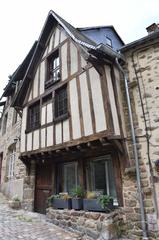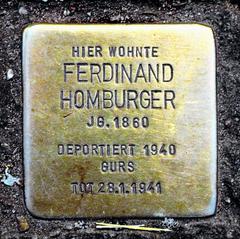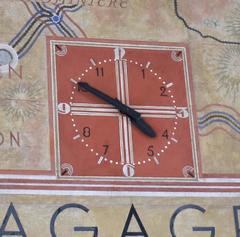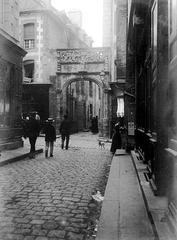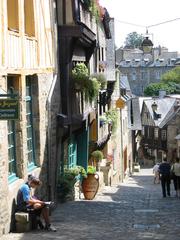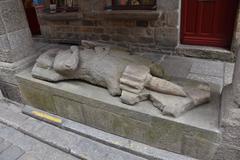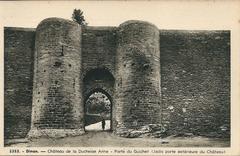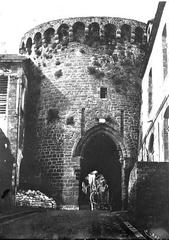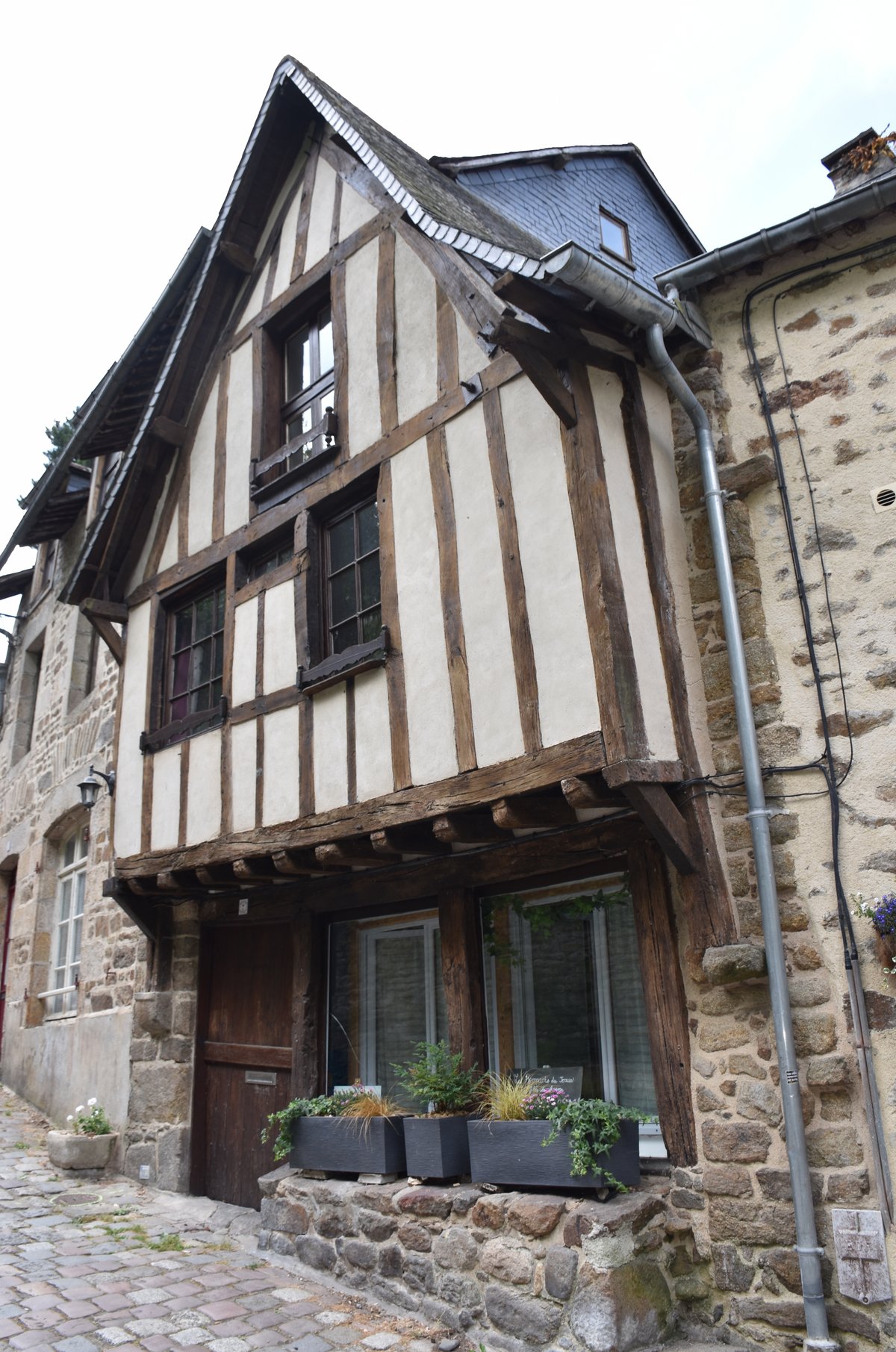
Maison 7 Rue Du Petit Fort, Dinan, France: Visiting Hours, Tickets, and Historical Sites Guide
Date: 14/06/2025
Introduction
Maison 7 Rue du Petit-Fort stands as a remarkable symbol of Dinan’s medieval heritage, set in the heart of Brittany’s most enchanting walled town. This comprehensive guide explores the rich history, architectural beauty, and cultural resonance of Maison 7, while providing all the practical details needed to plan your visit—including hours, tickets, accessibility, and nearby attractions.
Whether you’re a history enthusiast, architecture aficionado, or casual traveler, this guide will immerse you in the unique atmosphere of Rue du Petit-Fort and its iconic half-timbered houses. For up-to-date visitor information and events, consult the Dinan Tourist Office and trusted travel resources like Travel France Online.
Table of Contents
- Introduction
- Medieval Origins and Urban Development
- Architectural Significance
- Socio-Economic Role in Medieval Dinan
- Defensive Importance and Fortifications
- Preservation and Historical Recognition
- Cultural and Artistic Legacy
- Rue du Petit-Fort in Dinan’s Urban Fabric
- Notable Historical Events
- Visitor Information
- Travel Tips and Photographic Highlights
- Nearby Attractions
- Frequently Asked Questions (FAQ)
- Conclusion
- References
Medieval Origins and Urban Development
Rue du Petit-Fort is one of Dinan’s most significant medieval streets, historically connecting the bustling port on the River Rance to the fortified upper town. Dating to the Middle Ages, its steep cobbled incline was engineered to facilitate the movement of goods and people, reflecting Dinan’s role as a prosperous ducal stronghold and trading hub (Nomads Travel Guide). The street’s layout and architecture showcase urban planning priorities of the 13th–16th centuries: defensibility and economic vibrancy.
Architectural Significance of Maison 7 Rue du Petit-Fort
Maison 7 Rue du Petit-Fort exemplifies Dinan’s renowned half-timbered architecture (“maisons à colombages”), featuring oak-framed facades, carved brackets, and overhanging upper stories. Constructed in the late 15th or early 16th century, it reflects both the craftsmanship of the period and the social aspirations of Dinan’s merchant class. The building’s design—with upper floors projecting over the street—maximized living space and sheltered pedestrians, integrating practicality with aesthetic appeal (Wikimedia Commons).
Socio-Economic Role in Medieval Dinan
Maison 7 and its neighboring houses were once home to merchants, clothiers, and craftsmen integral to Dinan’s thriving port economy. The ground floors served as workshops or shops, while families lived above, enabling a vibrant mix of commerce and domestic life. The proximity to the port and strategic location on a principal thoroughfare facilitated the trade of textiles, salt, wine, and agricultural goods (Nomads Travel Guide).
Defensive Importance and Urban Fortifications
Rue du Petit-Fort’s defensive significance is underscored by its connection to the 14th-century Porte du Jerzual, part of Dinan’s extensive ramparts. The street’s steep gradient and narrow width aided defense against invaders, especially during conflicts like the War of the Breton Succession and the Hundred Years’ War. Maison 7’s robust construction reflects these times of uncertainty (Travel France Online).
Preservation and Historical Recognition
Maison 7 Rue du Petit-Fort is listed in the French inventory of Historic Monuments, with restoration efforts dating back to the 20th century. These initiatives have preserved its half-timbered facade, original stonework, and medieval character—allowing visitors to experience the ambiance of a 16th-century merchant’s home (Nomads Travel Guide).
Cultural and Artistic Legacy
Rue du Petit-Fort remains a hub of creativity, hosting artisan workshops, galleries, and specialty boutiques. Maison 7 frequently serves as a venue for art exhibitions and cultural events, making the street a living testament to Dinan’s enduring artistic spirit (Nomads Travel Guide).
Rue du Petit-Fort in Dinan’s Urban Fabric
Connecting the riverside port to the upper town, Rue du Petit-Fort exemplifies Dinan’s historic urban strategy—integrating commerce, defense, and daily life. Maison 7’s prominent position within this context highlights its role in shaping, and being shaped by, the town’s evolution (Travel France Online).
Notable Historical Events
Dinan’s strategic location made it a stage for pivotal events, such as the 1065 siege depicted in the Bayeux Tapestry. Over centuries, Rue du Petit-Fort and its houses have weathered conflicts, economic booms, and the daily rhythms of medieval and modern life (Travel France Online).
Visitor Information
Visiting Hours and Tickets
- Rue du Petit-Fort: Public and accessible at all times for exterior exploration.
- Maison 7 Rue du Petit-Fort: Primarily a private residence or commercial space. Interior access is occasionally available during guided tours or special events—check with the Dinan Tourist Office or local listings for current opportunities.
Accessibility
- The street’s steep, cobbled incline and medieval layout present challenges for those with limited mobility. Comfortable walking shoes are essential.
- Wheelchair access is limited, but alternative routes and accessible attractions exist in the upper town.
Guided Tours
- Local operators and the tourist office offer guided walking tours that often include Rue du Petit-Fort.
- During events like the Fête des Remparts, some private homes and workshops open for public visits (Travel France Online).
Travel Tips and Photographic Highlights
- Best light: Early morning or late afternoon for photos.
- Footwear: Flat, sturdy shoes recommended due to cobbles and incline.
- Amenities: Cafés and artisan shops line the street; public restrooms near the port and city center.
- Weather: Carry a raincoat or umbrella—Brittany weather is changeable.
Nearby Attractions
- Porte du Jerzual: Historic city gate at the top of Rue du Petit-Fort.
- Dinan Ramparts: Walkable medieval walls with panoramic views.
- Château-Musée de Dinan: 14th-century castle museum.
- Tour de l’Horloge: 15th-century clock tower with town views.
- Basilique St-Sauveur: Free entry, notable for its architectural blend.
- The Old Port: Riverside dining, boat cruises, and scenic walks.
- Artisan Workshops: Observe or buy local crafts along the street.
Frequently Asked Questions (FAQ)
Q: Is there an entrance fee for Rue du Petit-Fort or Maison 7?
A: The street is free to visit. Maison 7 is generally private but may open for tours or events.
Q: What are the best times to visit?
A: Early mornings or late afternoons for quiet and good light; July’s Fête des Remparts offers special access.
Q: Are guided tours available?
A: Yes, via local operators and the tourist office.
Q: Is the area wheelchair accessible?
A: Steep cobbles limit access; alternative routes are available elsewhere in Dinan.
Q: Where can I find up-to-date visiting information?
A: Check the Dinan Tourist Office or Travel France Online.
Conclusion
Maison 7 Rue du Petit-Fort captures the enduring spirit of Dinan’s medieval legacy, offering visitors a rare blend of historical authenticity, architectural splendor, and vibrant contemporary culture. With its preserved timber-framed facade, strategic location, and ongoing role in Dinan’s urban life, it stands as both a monument and a living part of the town’s identity.
Plan your visit with care—enjoy artisan boutiques, join a guided tour, participate in annual festivals, and experience the magic of Dinan’s old streets. For the richest experience, use the Audiala app for self-guided audio tours, and consult the latest information from trusted tourism resources.
Sources and Further Reading
- Nomads Travel Guide
- Travel France Online – Dinan Ramparts
- Tales from Brittany
- France Voyage
- Booking.com
- Travel France Online – Rue du Jerzual
- Dinan Tourist Office
